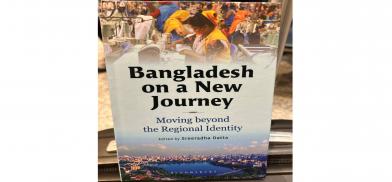Bangladesh's future will depend in many ways on the foreign policy choices it makes
Attention must also be paid to the changing structural dynamics within South Asia where countries (including Bangladesh) are increasingly working with each other, moving away from a primarily India-driven engagement within the neighbourhood.

Bangladesh’s growth story has caught global attention. From being described as an ‘international basket case’ in the early years of its independence, it has now become one of the ten fastest-growing economies globally. At the same time, Dhaka’s foreign policy outlook too has dramatically changed from being primarily inward-looking to one that is steadily growing its global outreach. Based on a pragmatic assessment of its needs and interests, Bangladesh has been actively engaging with states not only within its immediate neighbourhood but also with key partners elsewhere in the world.
However, Bangladesh’s pursuit to carve a place for itself globally will be affected by the ongoing great power rivalry, burgeoning economic concerns, and a fragmented world order. In the coming days, Dhaka will have to navigate an international arena that is exceedingly multipolar and far more geopolitically complex than ever before.
Against this backdrop, the book, Bangladesh on a New Journey: Moving Beyond the Regional Identity, examines key facets of Bangladesh’s foreign policy. Edited by Sreeradha Datta, the volume consists of 13 chapters as well as three other essays – a foreword by C Raja Mohan, a prologue by Michael Kugelman and an epilogue that I had the pleasure to write. The various articles contain a mix of thematic and bilateral focus, capturing the nuances of Bangladesh’s evolving foreign policy.
Search for identity
The first section of the book examines key aspects of Bangladesh’s identity. It begins with an articulation of an alternative ‘Bangladesh Doctrine’ of strategic autonomy and development deterrence by Rashed Al Mahmud Titumir. Touching on the issue of religion and foreign policy, Brigitta Schuchert writes on the impacts of Dhaka’s international positioning as a secular nation and a Muslim-majority country. Given a sizeable Bangladeshi diaspora population, Ali Riaz analyses the shifts in the construction and reconstruction of their identity over the years. The section wraps up with Ashley Johnson’s assessment of Bangladesh’s domestic and international efforts to address climate change challenges.
The second section contains a rigorous take on Bangladesh’s geopolitics. Humayun Kabir draws attention to Dhaka’s engagement with the outside world since the 1970s. Johannes Plagemann lays down the changes in the international system that have enabled secondary powers like Bangladesh to play a more central role globally. In her chapter, Datta focuses on the pivot to the Indo-Pacific region and the strategic opportunities and challenges that lie ahead. Don McLain Gill offers an insight into Bangladesh’s ties with Southeast Asia, looking at Dhaka as a bridge between South Asia and Southeast Asia.
The third section examines Dhaka’s key bilateral relations. This includes Bangladesh-India relations, which Deb Mukherji characterises as being in a ‘golden’ phase while also highlighting the need for both sides to address the various complexities. Li Jianjun discusses the formation, maintenance, and development of the strategic cooperative partnership between China and Bangladesh. Amna Ejaz Rafi traces the historical journey of the Liberation War, the current state of bilateral ties, and the possibilities for more engagement. Nilanthi Samaranayake reviews Washington-Dhaka ties right from its tepid beginnings to the present strong political and economic relations. Finally, Andrew Hunter focuses on the lack of Australian attention on Bangladesh and the prospects for a more meaningful bilateral relationship.
In March 2024, the volume was launched in Dhaka at a joint event organised by the Bangladesh Institute of International and Strategic Studies and the Bangladesh Foundation for Regional Studies. Published by Bloomsbury India, the book project was supported by the Institute of South Asian Studies at the National University of Singapore. The book has received a commendable reception among Bangladeshi academic and policy circles. It has been widely acknowledged as an important contribution to the articulation of Bangladesh’s evolving foreign policy and filling the gap in the international appreciation of Dhaka’s geopolitics.
Favourable geography
Here are some key takeaways from the discussions around the book in early March 2024.
First, the Bangladesh story has highlighted the need to reassess the definition of ‘small states’ and their position, role and interests within the international system. Attention must also be paid to the changing structural dynamics within South Asia where countries (including Bangladesh) are increasingly working with each other, moving away from a primarily India-driven engagement within the neighbourhood.
Second, in the coming days, Bangladesh must focus on reaping the strategic and economic gains from its favourable geography in the Bay of Bengal and the Indo-Pacific region. Importantly, a significant aspect of this would entail tapping into its blue economy resources and integrating them effectively.
Third, Bangladesh’s strategic significance today is reinforced by its noteworthy economic progress so far. While remittances and the readymade garments industry have been the primary contributors to growth so far, there is a need for sustainable long-term drivers of economic development to maintain the momentum. Furthermore, Bangladesh’s impending graduation from the United Nations’ List of Least Developed Countries will also bring new challenges that will have to be appropriately addressed.
Ultimately, it is undeniable that Bangladesh is at an important moment in its foreign policy journey. While the prevalent multipolarity provides it with an opportunity to reap significant strategic gains, the book aptly explains that Dhaka’s policy choices will determine its path ahead.
(The author is a Research Analyst at the Institute of South Asian Studies, National University of Singapore. Views are personal. She can be contacted at ramita.iyer@gmail.com )














Post a Comment